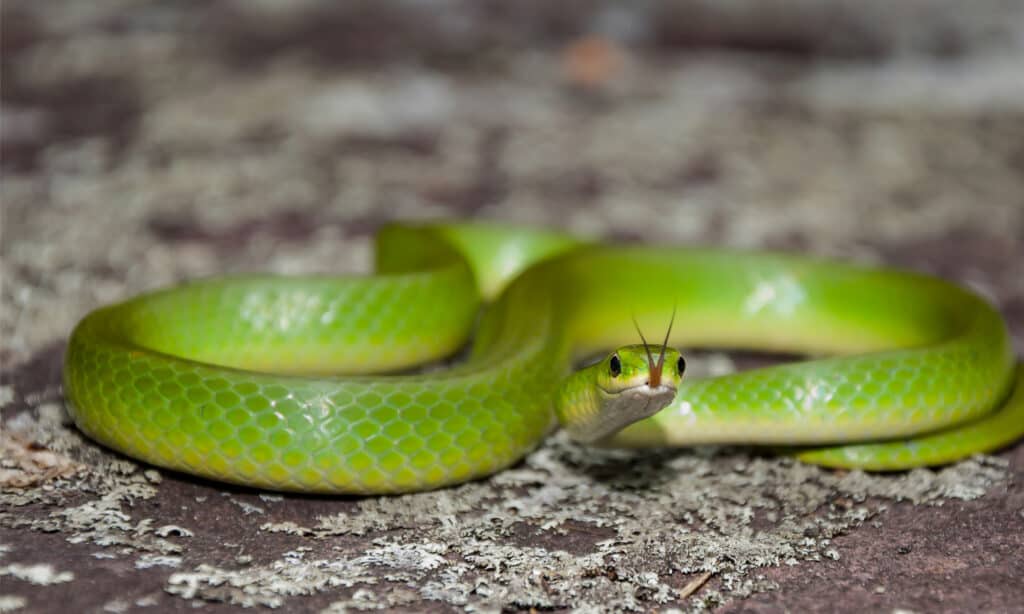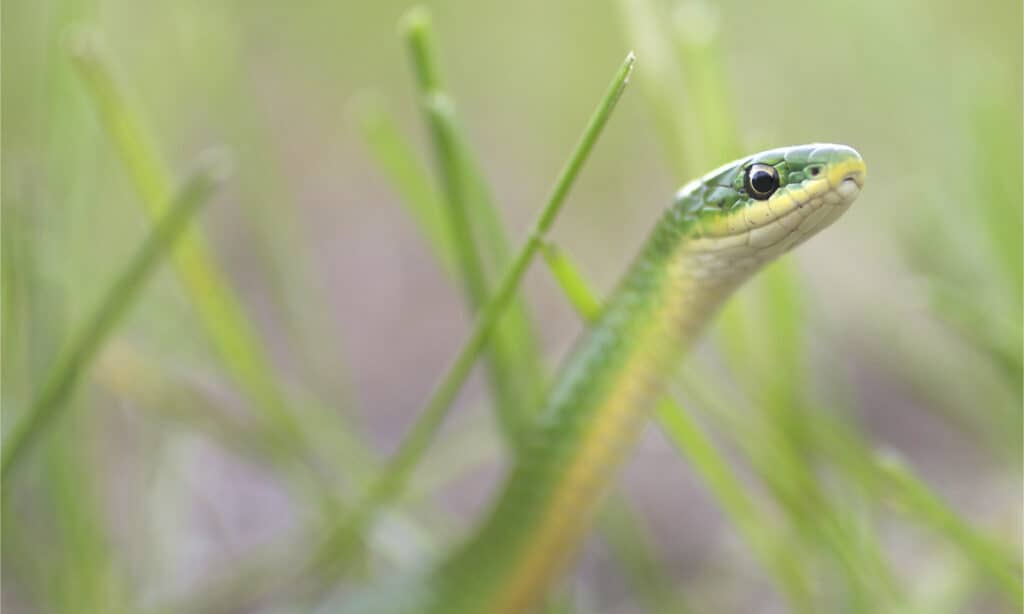Like its name, the smooth green snake (Opheodrys vernalis) has brilliant green scales that shine brightly in the sunlight and easily blend in with surrounding vegetation. With its large round eyes and thin snout, the smooth green snake looks like it is always smiling. The movements of this slender snake are smooth and graceful and remind us that even the smallest and most unassuming beings can be awe-inspiring in their own way. Smooth green snakes feed mainly on insects and play a very important role in pest control wherever they live. Let’s take a closer look at these charming snakes, and discover the largest smooth green snake ever recorded!
What Does the Smooth Green Snake Look Like?

Smooth green snakes have smooth scales along their backs and typically measure up to 20 inches in length.
©iStock.com/tamers1
Smooth green snakes are graceful reptiles with a stunning shade of green coloring their backs. Their bellies are a lovely shade of yellow or white that contrasts beautifully with the verdant scales on their backs. Like their name, smooth green snakes also have delicate and smooth dorsal scales that add to their charming appearance.
However, depending on where a smooth green snake lives, it may not always be quite as green as you may expect. For example, smooth green snakes in Kansas often exhibit a bluish shade rather than the characteristic bright green coloring. Smooth green snakes in the southwestern regions of Texas are often tinted with a light brown hue. In northern Wisconsin, they have a lovely bronze-toned color.
In addition, baby smooth green snakes are not born with that iconic vivid green coloring. Instead, they are born with more of a bluish-gray, dull olive green, and even brown coloring. Baby smooth green snakes are also quite small, measuring only 3 to 6.5 inches long! However, after their very first shed, these snakes reveal bright green scales just like their adult counterparts. After that, smooth green snakes can shed their skin every four to five weeks, giving them plenty of room for new growth!
What is the Largest Smooth Green Snake Ever Recorded?
The scientific classification of smooth green snakes is Opheodrys vernalis. Opheodrys come from Greek and means “tree serpent”, while vernalis comes from Latin and means “of springtime”. Quite the fitting name for such a vibrantly colored green snake!
Upon reaching adulthood, these brightly colored snakes measure between 14 and 20 inches in length with slender and delicate frames. However, the longest smooth green snake ever recorded was 26 inches long!
Where Do Smooth Green Snakes Live?

The largest smooth green snake ever recorded was 26 inches long.
©iStock.com/JasonOndreicka
Smooth green snakes are native to North America. They live in various regions of the United States, northern Mexico, and Canada. They prefer spending time on the ground, particularly in open areas near permanent water sources, such as along the edges of rivers and streams, marshes, and woodland areas. However, they also spend much of their time in natural green areas where they can use their beautiful green bodies as camouflage to keep them safe. In addition, smooth green snakes sometimes move their heads in a bobbing motion so that they look like plants blowing in the wind!
Smooth green snakes are cold-blooded reptiles, so they also spend much of their time in warmer areas where they can bask in the sunshine on rocks and logs to stay warm. When the weather gets too cold for these snakes, they seek out underground burrows and spend the winter hibernating in large groups. They mate in the later months of spring and lay their eggs in the summertime from June through September.
Are Smooth Green Snakes Dangerous?
No — smooth green snakes are not dangerous at all! In fact, these vibrantly colorful reptiles are non-aggressive, non-venomous, and very rarely bite. When they feel threatened, smooth green snakes will flee rather than fight. Sometimes they also secrete a foul-smelling substance to deter predators. Most of the time, however, these snakes rely on their grassy-green camouflage bodies to keep them out of sight.
What Do Smooth Green Snakes Eat?
Smooth green snakes have keen eyesight and can sense vibrations in their surroundings. With uniquely stretchy ligaments in their jaws, these snakes can swallow their prey whole — even if it’s wider than the snake’s body! Insects, spiders, and other small bugs make up the majority of a smooth green snake’s diet. They often eat ants, worms, slugs, snails, spineless caterpillars, moths, and spiders.
Threats and Conservation Status
Smooth green snakes are hunted by larger snakes, large birds like buzzards and hawks, and mammals like raccoons, foxes, and common house cats. However, their bright green coloring helps them to stay camouflaged and hidden most of the time. In addition, their lithe bodies are very agile and they can make quick escapes when they need to.
Currently, the wild populations of smooth green snakes are considered healthy and stable. Unfortunately, there are many threats that threaten their numbers and survival. Due to their striking color and calm demeanor, smooth green snakes are often collected as pets. However, they do not do well in captivity and rarely survive when taken from the wild. In addition, smooth green snakes live in small, isolated populations, so commercial collection can wipe out their groups very quickly. Furthermore, since insects and other bugs make up the majority of their diet, their numbers are declining because of the increased use of pesticides. Smooth green snakes are also threatened by urban development and habitat destruction of many kinds.

Smooth green snakes are not dangerous and they depend on their camouflage for survival.
©David Schliepp/Shutterstock.com
Similar Species: The Rough Green Snake
There is another nearly identical species of green snake in North America that is easily confused for a smooth green snake: the rough green snake (Opheodrys aestivus). As you may have guessed from their names, the most obvious distinction between these two snake species is the texture of their scales. The rough green snake has keeled or slightly ridged scales, giving its body a rough appearance and texture. The smooth green snake, on the other hand, has smooth and even scales.
In addition to the texture of their scales, there are a few other distinctions that can help differentiate between these two lovely green-colored snakes. The rough green snake grows much larger than the smooth green snake. Rough green snakes can sometimes measure over 45 inches in length — that is near twice the length of a smooth green snake! In addition, the rough green snake lives only in the southeastern United States. And, unlike smooth green snakes, rough green snakes are quite fond of climbing and often spend time hanging out in low vegetation.
The photo featured at the top of this post is © Kristian Bell/Shutterstock.com
Discover the "Monster" Snake 5X Bigger than an Anaconda
Every day A-Z Animals sends out some of the most incredible facts in the world from our free newsletter. Want to discover the 10 most beautiful snakes in the world, a "snake island" where you're never more than 3 feet from danger, or a "monster" snake 5X larger than an anaconda? Then sign up right now and you'll start receiving our daily newsletter absolutely free.
Thank you for reading! Have some feedback for us? Contact the AZ Animals editorial team.






